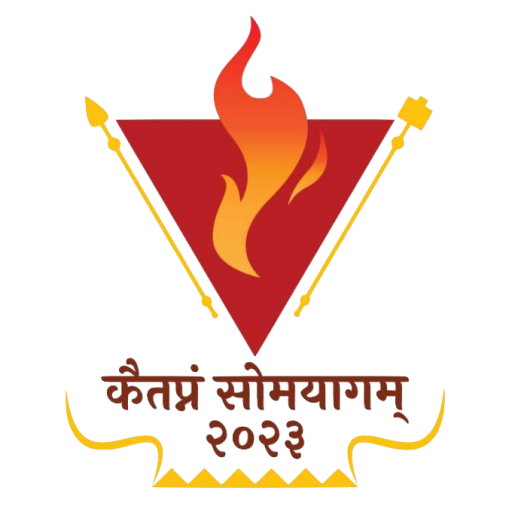Yajna or Yagna (also called yaga or yagam) is a Vedic sacrifice or an outer form of ritual worship, in which offerings are made to different deities in a prescribed and systematic manner by worshippers to nourish them and thereby supplicate them, so that they would assist the worshippers in achieving their goals and desires in life. It is usually done with the help of qualified priests. Yagam leads to Yogam, the auspicious state of harmony and unity with gods and happiness here and hereafter. Yajna is the means by which human beings can ensure their Wellbeing upon earth and a safe journey to the heaven after death. Indeed, in the Vedic world Yajna was the panacea to all human problems from martial discord to snakebites.
The word Yajna is derived from “yaj,” meaning divine worship. The objects of that worship are usually devas (gods). However, Yajnas are used worship divinities as well as to help and serve others or to commemorate important events and occasions. Hence, they are performed to honor kings, teachers, elders, sacred places, ancestors, venerable people or to celebrate occasions like the birth of a child, marriage, house-warming, etc.
Yajnas have an ethical basis too. They provide the human beings with an opportunity to transcend their selfishness and help others. The Vedas suggest that life itself should be led as a sacrifice in which every action should be an offering. Brahman himself is the ultimate sacrificer and he shows the way to engage in an eternal sacrifice. Thus, service to gods and others as an obligation to God in the upholding of Dharma is the central feature of Vedic Yajnas. They truly help humans lead a divine centered life, or what we today know as the Hindu way of life.
Yajnas are usually fire sacrifices and involves the use of ritual or sacrificial fire. However, in some rituals the use of fire may be symbolic. In Soma Sacrifices, the Soma Juice rather than fire was the main offering. Fire sacrifices were common in the ancient world. However, Vedic people perfected the art and science of Vedic sacrifices to the highest extent and built a whole culture and belief system around them. They made fire sacrifices obligatory to humans by suggesting that gods depended upon them for nourishment. At the zenith of the Vedic civilization, the ancient Zoroastrians also practiced fire sacrifices, which were known as Yasna.
Each Yajna is performed by the host of the sacrifice (Yajamana), his family, one or more attending priests, in the presence of friends, well-wishers and other guests. According to the tradition the remains of the sacrificial food from the yajna is shared by the participants. The Brahmanas receive fees and gifts. The knowledge of the Yajnas is contained in the Shrauta Shastras and Grihya Sutras. The Atharvaveda, in which the Vedic sacrificial rituals reach their highest culmination, extols Yajna as a deity in itself.
A notable feature of the Yajnas is that they are traditionally performed by men only. In Agnichayana or Agnistoma sacrifices, women have no role other than as participants, cooks or cohosts. A wife’s duty is to serve the host of the sacrifice and his family to perform his sacrificial duties and help him in fulfilling his obligation to the beneficiaries of the sacrifice. However, in certain types of Yajnas, especially those which were performed on the occasion of marriage or for progeny, consummation of marriage, conception, pregnancy or sexual gratification, the participation of women was mandatory. Women also played an important role in Rajasuya and Asvamedha sacrifices and in full moon and half moon sacrifices.
Although the Yajamana, the host of the sacrifice, was supposed to be the key figure (swamin) in the sacrifices, in course of time he was reduced to a mere donor or supporter of the sacrifice. His main duties were limited to fulfilling his obligation to follow the instructions of the head priest, pay the fees to the participating priests, bear the costs of the sacrifice and ensure fair distribution of food to the guests.
In almost all important Yajnas, priests play a predominantly important role. Their participation and involvement is mandatory for most sacrifices. The Brahmanas are the gods of the mortal world. Hence, they are most qualified to communicate with the gods of heaven. Besides, the Yajnas provide an opportunity to people to make gifts to Brahmanas and thereby accumulate great merit
In the Vedic period the Kshatriyas had an upper hand in certain Yajnas such as Rajasuya and Asvamedha. However, with the decline of the Kshatriya power in the post Vedic period, their influence waned. The kings who established kingdoms in the North and the South after them were mostly from lower castes or foreigners. They had no knowledge of the Vedas and had to depend entirely upon the priestly class to perform the sacrifices. Further, the codification of caste based laws by Manu and others and restrictions upon the teaching of the Vedas helped the traditional Brahmana families monopolize the knowledge of the sacrifices and keep it out of the reach of common people. Due to such factors, Yajnas became the mainstay of Brahmana caste and remained the main source of their livelihood for centuries.
